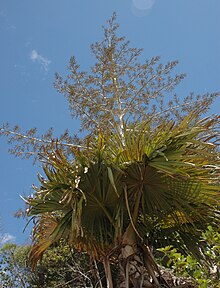Tahina spectabilis
| Tahina spectabilis | |
|---|---|

| |
| Scientific classification | |
| Kingdom: | Plantae |
| Clade: | Tracheophytes |
| Clade: | Angiosperms |
| Clade: | Monocots |
| Clade: | Commelinids |
| Order: | Arecales |
| Family: | Arecaceae |
| Subfamily: | Coryphoideae |
| Tribe: | Chuniophoeniceae |
| Genus: | Tahina J. Dransf. & Rakotoarinivo, 2008 |
| Species: | T. spectabilis
|
| Binomial name | |
| Tahina spectabilis J. Dransf. & Rakotoarinivo, 2008
| |
Tahina spectabilis, the tahina palm, also called blessed palm or dimaka is a species of gigantic
Taxonomy
The species, which produces countless flowers and (after fruiting) dies, is sufficiently different from other known palms to justify the creation of the monotypic genus Tahina,


Description
The palm is one of the largest of the 170 palm species native to Madagascar, having a trunk up to 18 m (59 ft) tall and leaves which are over 5 m (16 ft) in diameter.[8]
Tahina spectabilis normally appears much like other palms. However, when it flowers, which John Dransfield of the Royal Botanic Gardens, Kew estimates as occurring after 30 to 50 years, the stem tip grows a large inflorescence that bursts into branches of hundreds of flowers. The drain on nutrients this display entails results in the death of the organism within several months.[9] This leads to the common name for the palm – Suicide Palm.[10]
Discovery
The tahina palm was discovered by French cashew plantation manager Xavier Metz and his family, who were strolling through a remote northwestern region of Madagascar in 2007 when they came across a flowering individual and sent photos to the Kew Gardens for identification.[9]
Its name is derived from "Tahina", a Malagasy word meaning "to be protected" or "blessed", being the given name of Anne-Tahina Metz, the daughter of its discoverer, while "spectabilis" means spectacular in Latin.[8]
It was subsequently chosen as one of the top ten species discoveries of 2008 by the International Institute for Species Exploration.[11]
References
- . Retrieved 19 November 2021.
- .
- ^ "Giant Palm Trees Puzzle Scientists". BBC News. 17 January 2008. Retrieved February 26, 2008.
- ^ "Top 10 - 2009: A Palm that Flowers Itself to Death". Arizona State University. Archived from the original on May 25, 2009.
- .
- ^ "Giant palm found on Madagascar flowers itself to death", AFP, 16 January 2008 (hosted by Yahoo! News) Archived 26 January 2008 at the Wayback Machine
- ^ "Self-destructing palm tree discovered in Madagascar", "Associated Press", 16 January 2008 (hosted by CNN) Archived 19 January 2008 at the Wayback Machine
- ^ a b "New Genus of Self-destructive Palm found in Madagascar". Royal Botanic Gardens, Kew. January 2008. Archived from the original on January 19, 2009. Retrieved November 22, 2014.
- ^ a b Eccleston, Paul (17 January 2008). "Self destructing palm tree found in Madagascar". The Daily Telegraph. Archived from the original on 8 October 2014. Retrieved 26 June 2013.
- ISBN 978-0-900881-67-1. Archived from the original(PDF) on 2012-10-21.
- ^ Arizona State University (May 23, 2009). "Pea-sized Seahorse, Bacteria That Life In Hairspray, Caffeine-free Coffee Among Top 10 New Species Of 2008". ScienceDaily. Retrieved November 22, 2014.
External links
 Media related to Tahina spectabilis at Wikimedia Commons
Media related to Tahina spectabilis at Wikimedia Commons

